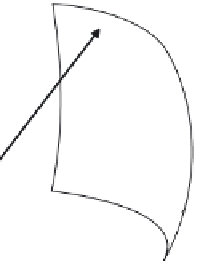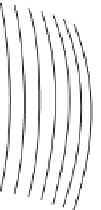Graphics Reference
In-Depth Information
p
= (
x
,
y
,
z
)
L
(
u
,
v
,
s
,
t
)
v
t
u
s
(
s
,
t
)
(b)
Figure 5.16
Basic concept of the light field. (a) The plenoptic function contains the radiance in each
viewing direction, parameterized by
s
and
t
, at each point
(
x
,
y
,
z
)
in space. (b) The light
field is a function on lines in space, lines are parameterized by the plane coordinates of their
intersection with two distinct planes. The set of all lines through two rectangles is called a
light slab
. ((a) After [McMillan and Bishop 95]; (b) After [Levoy and Hanrahan 96].)
(a)
The light field for a light slab is represented as a collection of 2D images, with
one image for each discrete
(
u
,
v
)
parameter.
5.4.2 Construction of a Light Field
Constructing the light field for a virtual environment is relatively simple: the
samples for a light slab can be computed by tracing rays along the corresponding
lines. However, the light field does have to be prefiltered in the 4D line space
to avoid aliasing. This filtering has the side effect of introducing a blurring in
depth, but as happens, this ends up being desirable. Constructing the light field
from digitized photographs is much more difficult, as it requires a large number
of photographs, camera calibration, precise knowledge of the camera positions,
and a way to resample the images to match the light slab parametrization.
For a particular object or environment, constructing the light field starts by
choosing the light slabs. A single light slab cannot capture all directions of light
coming off an object, so more than one slab may be necessary to adequately
represent the light field. However, the light field of a single slab might be enough
if the set of views it represents is sufficient for the particular application. Gortler
and his collaborators proposed using light slabs based on the faces of a cube.
Other arrangements are possible, and may in fact be necessary. One or both of the
planes can even be placed “at infinity” to facilitate rendering orthographic views.
The distribution of directions for a slab is best illustrated using a 2D sim-
plification; the “Light Field Rendering” paper includes several such illustrations.











































